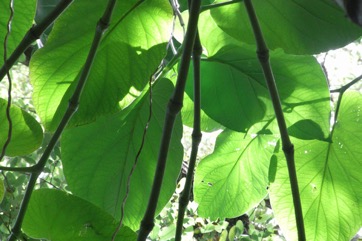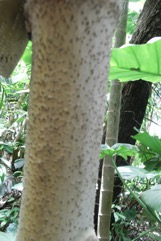Ear-leafed pepper, Mexican pepper leaf

A tropical plant. It suits seasonally moist, moderate rainfall. It can grow in an average, well-drained soil. It can grow in full sun or light shade. In Costa Rica it grows from sea level to about 1,700 m altitude. It suits hardiness zones 10-12.
Also known as:
Acuja, Acuyo, Anisillo, Bullhoof pepper, Caisimon, Cordoncillo, Hierba santa, Hoja de estrella, Hoja de Santa Maria, Hoja Santa, Makulan, Mexican pepper leaf, Root beer plant, Sacred pepper, Santamaria, Tlanepa, Ugudi bagasu, Yerba santa
Synonyms
- Artanthe aurita (Kunth) Miq.
- Artanthe seemanniana Miq.
- Piper alstonii Trel.
- Piper auritilaminum Trel.
- Piper auritilimbum Trel.
- Piper auritum var. amplifolium C.DC.
- Piper auritum var. seemannianum (Miq.) Trel.
- Piper heraldi Trel.
- Piper heraldi var. amplius Trel.
- Piper heraldi var. cocleanum Trel.
- Piper perlongipes Trel.
- Piper rafaeli Trel.
- Schilleria aurita (Kunth) Kunth
Edible Portion
- Leaves, Stem, Leaves - tea, Flower spikes - flavouring
Where does Ear-leafed pepper grow?
Found in: Amazon, Belize, Caribbean, Central America, Colombia, Costa Rica, Cuba, Ecuador, El Salvador, French Guiana, Guatemala, Guianas, Haiti, Honduras, Jamaica, Mexico, Micronesia, Nicaragua, North America, Pacific, Panama, South America, Suriname, West Indies
Notes: There are between 1000-2000 Piper species. They are mostly in the tropics.
Status: It is a cultivated food plant. Leaves are sold in local markets.
Growing Ear-leafed pepper, Mexican pepper leaf
Cultivation: It can spread by suckers. Seeds are also scattered by bats.
Edible Uses: The leaves are used to flavour soups and other dishes. It has the smell and flavour of sarsaparilla. It is used to flavour wild game such as armadillo, freshwater snails and is wrapped around dough. CAUTION: Hoja santa oil contains saffrole which can cause cancer. It should therefore only be used in small amounts. The young leaves are sometimes cooked and eaten as greens.
Nutrition Info
per 100g edible portion| Edible Part | Energy (kcal) | Protein (g) | Iron (mg) | Vitamin A (ug) | Vitamin c (mg) | Zinc (mg) | % Water |
|---|---|---|---|---|---|---|---|
| - | - | - | - | - | - |
Ear-leafed pepper, Mexican pepper leaf Photos


References
Altschul, S.V.R., 1973, Drugs and Foods from Little-known Plants. Notes in Harvard University Herbaria. Harvard Univ. Press. Massachusetts. no. 480
Arellanes, Y., et al, 2013, Influence of traditional markets on plant management in the Tehuacan Valley. Journal of Ethnobiology and Ethnomedicine 9:38
Blake, S. F., Native Names and Uses of some Plants of Eastern Guatemala and Honduras. Contributions from the National Herbarium. p 97
Chizmar Fernandez, C., et al, 2009, Plantas comestibles de Centroamerica. Instituto de Biodiversidad, Costa Rica. p 256
Coe, F. G., and Anderson, G. J., 1996, Ethnobotany of the Garifuna of Eastern Nicaragua. Economic Botany 50(1) pp 71-107
Coe, F. G. and Anderson, G. J., 1999, Ethnobotany of the Sumu (Ulwa) of Southeastern Nicaragua and Comparisons with Miskitu Plant Lore. Economic Botany Vol. 53. No. 4. pp. 363-386
Creasey, R., 2000, Edible Mexican Garden. Periplus. p 36
Diaz-Betancourt, M., et al, 1999, Weeds as a future source for human consumption. Rev. Biol. Trop. 47(3):329-338
Duke,
Facciola, S., 1998, Cornucopia 2: a Source Book of Edible Plants. Kampong Publications, p 171
Grandtner, M. M., 2008, World Dictionary of Trees. Wood and Forest Science Department. Laval University, Quebec, Qc Canada. (Internet database http://www.wdt.qc.ca)
Grandtner, M. M. & Chevrette, J., 2013, Dictionary of Trees, Volume 2: South America: Nomenclature, Taxonomy and Ecology. Academic Press p 501
Ibarra-Manriquez, G., et al, 1997, Useful Plants of the Los Tuxtlas Rain Forest (Veracruz, Mexico): Considerations of their Market Potential. Economic Botany, Vol. 51, No. 4, pp. 362-376
Kermath, B. M., et al, 2014, Food Plants in the Americas: A survey of the domesticated, cultivated and wild plants used for Human food in North, Central and South America and the Caribbean. On line draft. p 664
Larios, et al., 2013, Plant management and biodiversity conservation in Náhuatl homegardens of the Tehuacán Valley, Mexico. Journal of Ethnobiology and Ethnomedicine 2013 9:74.
Lentz, D. L., 1993, Medicinal and Other Economic Plants of the Paya of Honduras. Economic Botany, Vol. 47, No. 4, pp. 358-370
Llamas, K.A., 2003, Tropical Flowering Plants. Timber Press. p 313
Martin, F.W. & Ruberte, R.M., 1979, Edible Leaves of the Tropics. Antillian College Press, Mayaguez, Puerto Rico. p 212
Morton,
Pena, F. B., et al, 1998, Los quelites de la Sierra Norte de Puebla, Mexico: Inventory Y Formas de Preparacion. Bol. Soc. Bot. Mexico 62:49-62
Plants of Haiti Smithsonian Institute http://botany.si.edu/antilles/West Indies
F. W. H. A. von Humboldt et al., Nov. gen. sp. 1:45[folio]; 1:54[quarto]. 1816
World Checklist of Useful Plant Species 2020. Royal Botanic Gardens, Kew
Zuchowski W., 2007, Tropical Plants of Costa Rica. A Zona Tropical Publication, Comstock Publishing. p 64